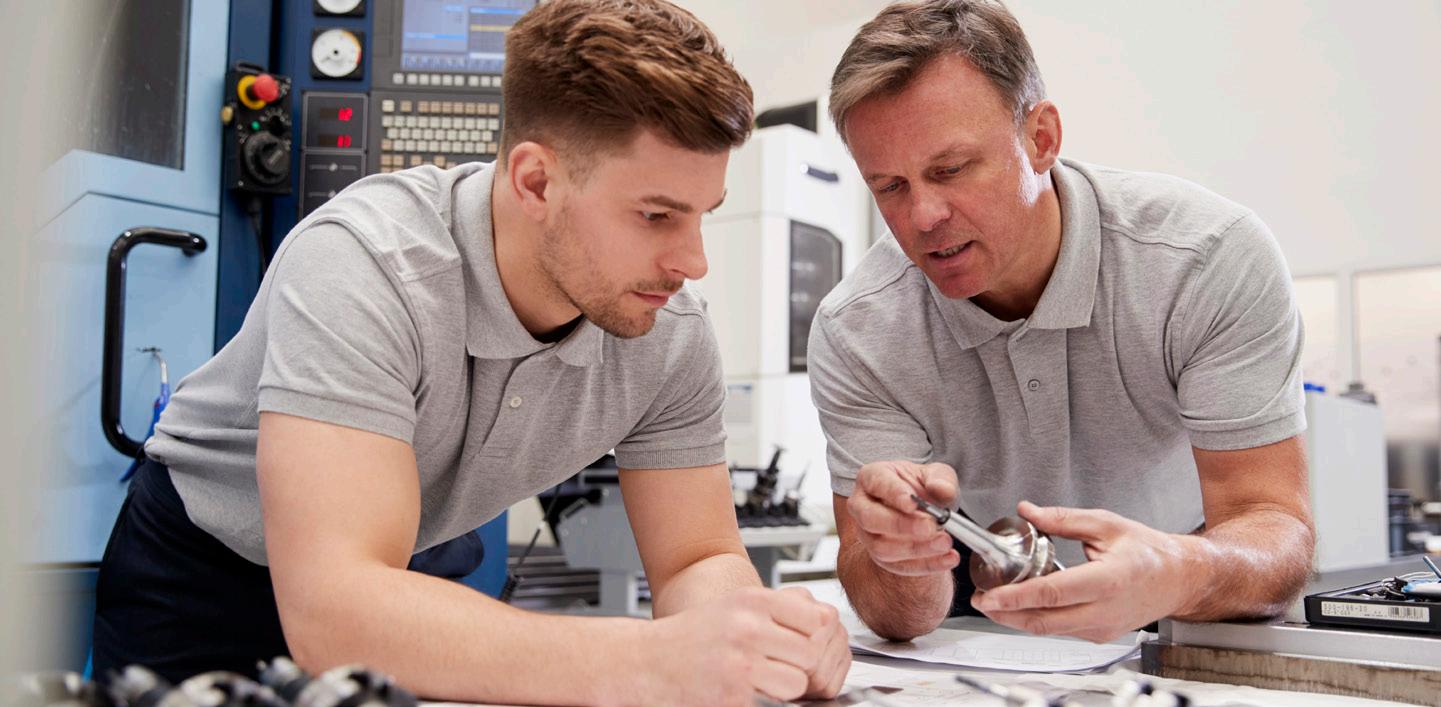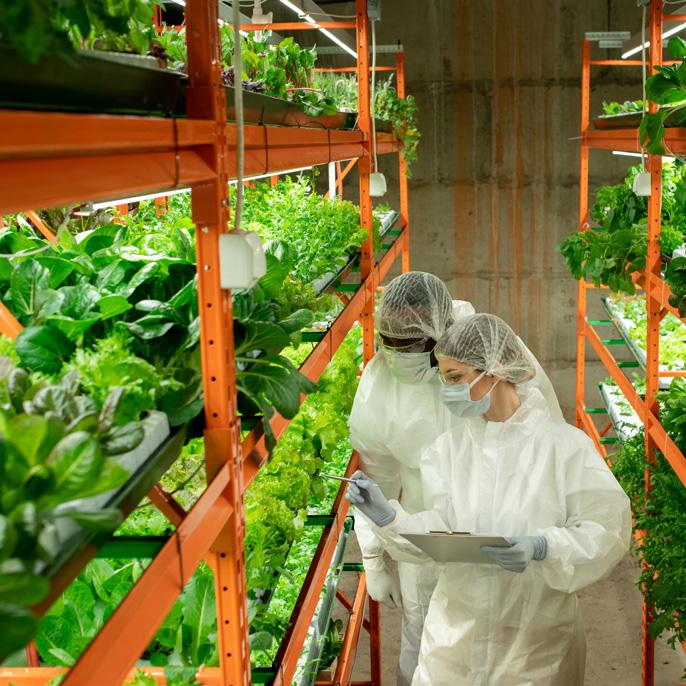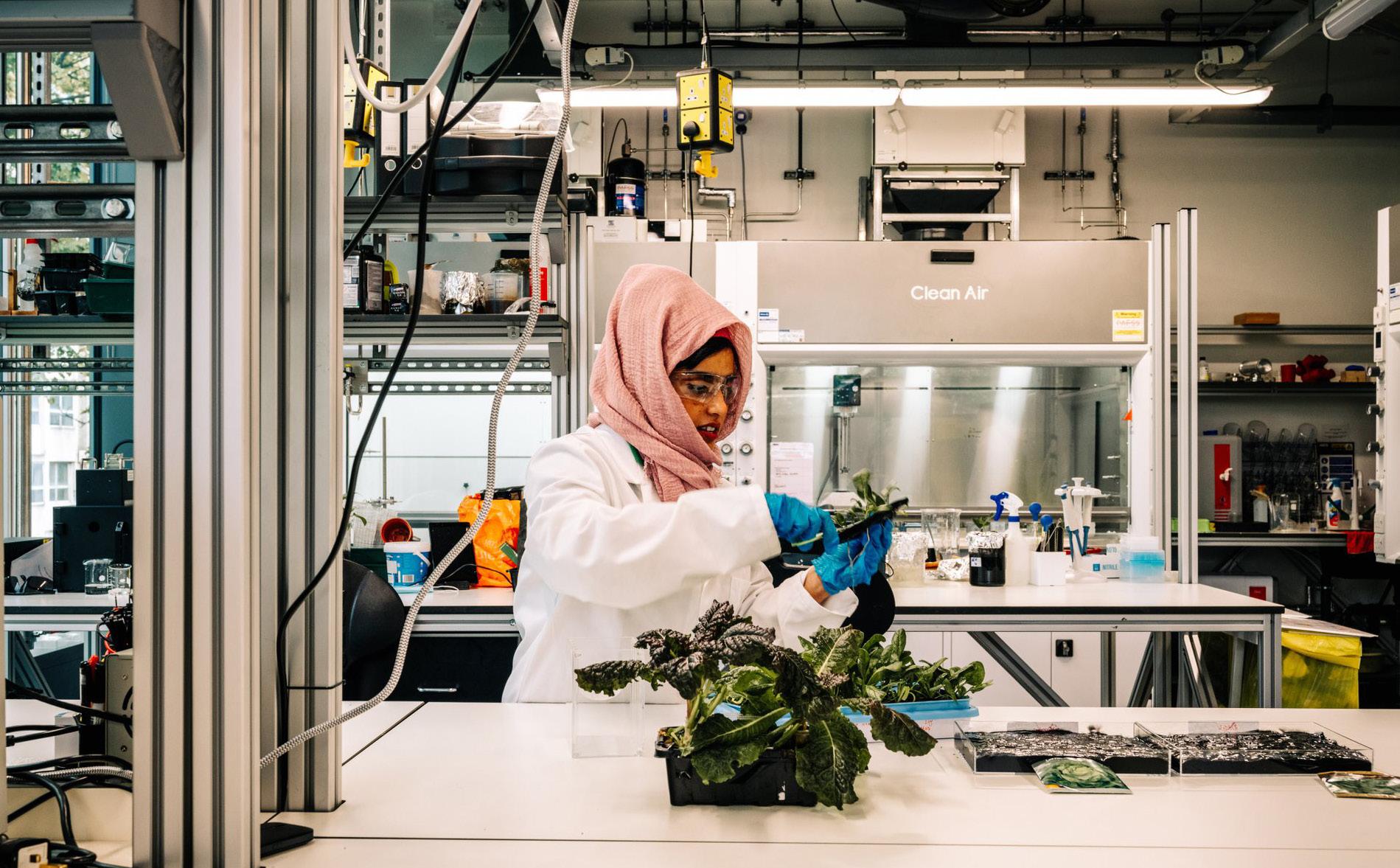
20 minute read
How will innovation have shaped Greater Manchester in 2038?
Greater Manchester in 2038, as enabled by advanced materials
ENERGY AND TRANSPORT
Advertisement
FAST FACTS: Greenhouse gas emissions from the transport sector have more than doubled since 1970, with around 80% of this increase coming from road vehicles. Currently, the transport sector is almost completely dependent on fossil fuels. It contributes approximately one quarter of all energy-related carbon dioxide emissions. Source
Switching to an electric car can help improve air quality and boost green jobs — if the electricity is powered by renewables. By achieving a 60% share of battery-electric and plugin hybrid vehicles on the road, more than 60 billion tons of CO2 could be saved between now and 2050. A radically different approach to local, national and international travel are key to Greater Manchester’s ambitions to achieve net carbon neutrality by 2038 and many of the solutions are already being engineered within the city region.
New batteries, supercapacitors and lightweighted composites will increase the scale and range of electrified transport. Similarly, lightweighting of vehicle components is already supporting the move to more energy efficient means of transport.
Used as an additive, graphene and other 2D materials can improve multiple elements of vehicles. When combined with rubber, it could potentially give a tyre both durability and grip. This could mean no more trade-offs between longevity and traction. One company, SpaceBlue - a spin-out from The Univerity of Manchester - even looks to recycle tyres after they have reached the end of their life, by converting them into hardwearing floor mats, which have been enhanced with tiny amounts of graphene.
The 2D material can also be used to form compounds with other elements of a car to make it lighter. Briggs Automotive Company, a partner in Manchester’s Graphene Engineering Innovation Centre (GEIC - the world-class advanced materials innovation accelerator), built the Mono, ‘the first production car in the world to fully incorporate the use of graphene-enhanced carbon fibre in every body panel’.
The material improved the structural properties of the fibre to make the supercar’s panels stronger and lighter, while also significantly improving the car’s mechanical and thermal performance.
Even outside of the car, the material could help make a difference to road users. Responsible for the UK’s motorways and major roads, Highways England is working with the GEIC to explore the addition of graphene to bitumen in road surfaces. The aim is to make roads
not only hard wearing but flexible when it comes to extreme weather. If surfaces are able to expand and contract to adapt to hot and cold conditions, the likelihood of potholes would decrease, alongside the potential for damage to vehicles.
But how does graphene play into current automotive trends? As the industry experiences an electrified undercurrent, pulling vehicle development towards e-mobility, a material which decreases weight could be essential.
Light-weighting is a key challenge with electric cars as they get progressively heavier. This process can help shed weight from all over the car, including the interior, with plastics and fabrics being made thinner and lighter. The less an electric vehicle (EV) weighs, the less work the motors will have to do and the more efficient the car will become. Graphene can also be added to battery elements, such as the casing, to make it lighter and tougher, as well as more thermally conductive.
Ultracapacitor specialist Skeleton Technologies, also recently partnered with the Karlsruhe Institute of Technology, to complete the development of a graphene ‘SuperBattery.’ With a 15-second charge time, the unit would also be capable of charging cycles counted in hundreds of thousands. The company claims this makes it ‘a perfect solution for the three main issues affecting electric vehicles: slow charging times, battery degradation, and range anxiety.’
It is possible that a car’s door or floor panels could one day store energy, although a challenge would be dealing with a potential collision, and what would happen if a panel became damaged.
Going forward, graphene could be crucial to the development of a new type of supercapacitor. This could allow vehicles to be equipped with a relatively smaller battery for range, which is then supplemented with a supercapacitor used for acceleration. For taxis and buses, which do a lot of stop-start driving, this split would be ideal as they would receive better range and performance from a supercapacitor that can recharge through braking.
The University of Salford is playing a leading role in developing technologies with industry that will support the quest for net carbon neutrality, including plans for the Salford Innovation Triangle – an innovation cluster demonstrating the potential for Innovation Greater Manchester.
The Energy House Laboratories are helping businesses understand how effective their products and services are in lowering consumers’ carbon footprint and reducing energy bills. The new North England Robotics Innovation Centre will be a beacon for the University of Salford’s robotics and automation specialisms,
HEALTHCARE REIMAGINED
Greater Manchester is leading research that will reimagine the delivery of healthcare, enabled by new technological advances utilising advanced materials including graphene.
By 2038 it is likely that biosensors, tissue regeneration and new treatments for cancer and neurological disorders will have helped to revolutionise medicine.
In 2021, a consortium led by The University of Manchester launched a new multi-million-pound research and innovation institute that will build on Manchester’s academic strengths in digital health and advanced materials to discover innovative health and care solutions. The Christabel Pankhurst Institute for Health Technology and Innovation is part of an ambitious plan set out in the Greater Manchester (GM) Local Industrial Strategy to boost the cityregion’s provision in this area.
It is being launched following a £5 million Local Growth Fund award from Greater Manchester Local Enterprise Partnership (GM LEP) and Greater Manchester Combined Authority (GMCA). The consortium is made up of the University, Manchester Science Partnerships supporting innovation that will be vital in achieving net carbon neutrality and improved health outcomes.
Other potential alternative energy sources which are being explored in Greater Manchester include hydrogen, while advanced materials which are electrically conductive offer the potential to charge and power vehicles as they pass along the city streets.
Based in the GEIC, collaborative research by Australia’s First Graphene and the Manchester Fuel Cell Innovation Centre at Manchester Metropolitan University has proven that metal oxide coated graphene can be an effective catalyst for nextgeneration hydrogen fuel cells. The skies above Greater Manchester in 2038 could be filled with more efficient flying vehicles too. Graphene enhanced composites are stronger for the same mass of material.
This light-weighting means less material can be used and the aircraft range increased without compromising the structural integrity.
A graphene skinned aircraft named ‘Juno’, was unveiled in 2016 at the Farnborough International Airshow. The future for travel and transport is already being imagined.
(MSP), The University of Manchester NHS Foundation Trust (MFT), and Health Innovation Manchester (HInM).

The initiative will build on investments from the University, Manchester Science Partnership, the Engineering and Physical Sciences Research Council (EPSRC), and The Alan Turing Institute, creating a total budget of more than £25 million.
The aim of the collaboration is to capitalise on the University’s strengths in digital health and advanced materials and develop innovative products and services for the health care sector. In turn this will drive business growth and employment as well as boost the long-term health benefits of the city-region.
Live examples of research utilising advanced materials include developing frameworks for the growth of replacement body parts and structures.
A collaboration between two Barcelona institutions and the Nanomedicine Lab at The University of Manchester - aimed at treating brain disorders such as epilepsy and Parkinson’s Disease - has secured £12 million in funding, one of the largest investments to date in the European medical nanotechnology industry.
INBRAIN Neuroelectronics is a spin-out company from the Catalan Institute of Nanoscience and Nanotechnology (ICN2) and the Catalan Institution for Research and Advanced Studies (ICREA), partners of - and supported by - the European Commission’s Graphene Flagship programme.
INBRAIN’s work involves the decoding of brain signals by implanting innovative, flexible nanoscale graphene electrodes, developed in conjunction with researchers at Manchester’s Nanomedicine Lab and the National Graphene Institute (NGI). These signals may then be used to produce a therapeutic, personalised response for patients with epilepsy, Parkinson’s and other neurological disorders.
Manchester-based ProMake discovered that graphene is an effective medical solution for reconstructive surgery. In leading their business from Manchester, they have been able to turn graphene into a functional form for their pioneering work.
See full ProMake case study on page 13.
At the University of Salford, The Health Sciences Research Centre (HSRC) is a multidisciplinary group, focused on improving health outcomes through innovation, research and partnerships. The centre has a strong focus on technological advancement, often working closely with NHS and industry partners to develop and test new treatments and to create innovative healthcare products and services.

EMPLOYMENT AND SKILLS
Achieving net carbon neutrality by 2038 will require new jobs and skills in industries that are only now being imagined.
Some new roles will be created in retrofitting public and private sector buildings to increase energy efficiency and reduce carbon production.
The Greater Manchester Retrofitting Task Force, chaired by Mayor of Greater Manchester Andy Burnham, is setting out a detailed action plan to deliver low-carbon retrofitting across the city-region.
Its aim will be to outline how home and building improvements can take place on a mass scale, while identifying opportunities to boost new skills, create good jobs, and drive investment in low-carbon industries.
All of these goals are designed to support a sustainable economic recovery from the pandemic and meet Greater Manchester’s target of achieving carbon neutrality by 2038.
The Task Force will include representatives from local and national government, social landlords, building authorities, colleges, energy suppliers, industry experts and investors.
The single biggest source of carbon emissions in Greater Manchester is heating, totalling 2.8 megatons of carbon dioxide and other greenhouse gases every year. While a variety of renewable heating systems exist, the low efficiency of many houses and commercial buildings has meant they are often unaffordable for residents.

An estimated 60,000 buildings would need to be upgraded in Greater Manchester every year if the cityregion is to achieve its target of becoming net-zero carbon by 2038.
Retrofitting just 20 per cent of Greater Manchester’s 1.2m homes would create a market size in the region of £3-£5.4bn, generating local and inward investment opportunities.
WATER
FAST FACTS: Water is a precious resource: Less than 3% of the world’s water is fresh (drinkable), of which 2.5% is frozen in Antarctica, the Arctic and glaciers. And humans are misusing and polluting water faster than nature can recycle and purify water in rivers and lakes. Source
Severe water scarcity affects about four billion people, or nearly two thirds of the world population, at least one month each year.
Agriculture is by far the largest water consumer, accounting for 69% of annual water withdrawals globally. According to the United Nations, water use has been growing globally at more than twice the rate of population increase in the last century, and an increasing number of regions are reaching the limit at which water services can be sustainably delivered, especially in arid regions.
Climate change has brought additional concerns about the potential impact of severe flooding on modern cities’ water supplies.
More than 2 billion people live in countries experiencing high water stress and 1.42 billion people – including 450 million children – live in areas of high or extremely high water vulnerability (UNICEF, 2021).
BUILT ENVIRONMENT AND SMART CITIES
FAST FACTS: According to Chatham House, the global production of cement – the ‘glue’ that holds concrete together – accounts for a staggering 8% of the world’s CO₂ production. Source
Innovation in advanced materials offers the disruptive potential to transform the way we build our future cities – and make them greener and smarter.
Construction is associated with the so-called Foundation Industries – which span the cement, glass, ceramics, metals, paper and bulk chemicals sectors – which in total produce 28 million tonnes of A revolution in water filtration developed at The University of Manchester could provide a muchneeded solution, with ready access to affordable clean water finally a real possibility for the world.
Desalination technologies could bring fresh water to everyone, but are currently very costly. Graphene-oxide membranes developed at Manchester’s National Graphene Institute (NGI) were initially used to filter out small nanoparticles and organic molecules from water. Common salts used in desalination technologies, however, could not be sieved. The membranes would become slightly swollen when they were immersed in water, which meant smaller salts could flow through the expanded membrane along with the water.
Manchester researchers in the membranes lab developed a strategy to avoid the swelling of the graphene-oxide membrane in water. They enabled the pore size in the membrane to be precisely controlled – and common salts to be sieved out of salty water – making it safe to drink. With the potential to revolutionise water filtration across the globe, the University’s new technology could: • bring affordable water filtration to countries that cannot afford largescale desalination plants, giving clean water to millions of people who need it most • offset the effects of climate change, or natural disasters such as severe flooding, on modern cities’ water supplies, providing affordable and sustainable alternative water solutions. Greater Manchester is renowned as a city-region with plenty of fresh water, but could its work with advanced materials one day provide provide a cheap, clean and efficient addition to the global water cycle - making MATERIALS RESEARCH sea water drinkable?
materials per year and account for up to 10 per cent of the UK’s total CO₂ emissions.
If we consider the Climate Change Act (2008) and the UK Government’s call to reduce carbon emissions to 80 per cent below the levels that were seen in 1990 by 2050 then clearly this sector is an obvious focus for a new approach. Innovation in new materials will greatly help city planners, developers and builders to construct a zero-carbon world from the foundations up.
By 2038, advanced materials could have helped to transform the skyline of Greater Manchester still further, while making construction practices more sustainable. Studies have suggested that adding just 0.03% graphene powder increased the strength of concrete by a conservative average of 25%.
“What’s exciting on the sustainability agenda is this circular economy,” says James Baker. “So, for example, our construction in the future, we might add graphene into concrete.
“That would enable us to use equivalent performance of the concrete for less material.
“So by adding less than 0.1 percent graphene into concrete, you could potentially use 30 to 50% less concrete. That’s not only a lower material footprint, it’s also lower CO2 footprint from the production of concrete and it’s also a lower
footprint in terms of cement mixers and lorries in a city centre where those buildings are taking place.”
Advanced materials could also support the smart cities of the future – allowing technologies that could better integrate and manage our utility and energy systems to be embedded within the fabric of the city.
As an example, the Graphene Engineering Innovation Centre is currently working on a number of projects with Highways England, the Government company responsible for much of the nation’s road network, and Arcadis, a leading global design and consultancy firm for natural and built assets.
An example might be when electric circuitry needs to be applied to the network, usually underground, and the feasibility of developing technology that could be embedded within the road structure itself and laid at the same time as the highway, for example, as an integral part of the structure.
But what if we could have this multifunctional capability used across all the infrastructure and buildings that make up a town or city? It would transform connectivity and make the very fabric of our built environments responsive and intuitive to our daily needs.
So, we can start to imagine charging points that are embedded across our road network – and every time an electric vehicle comes to a stop at traffic lights or rests in a parking space it can be charged in situ. If the vehicles of the future were using hybrid energy storage – i.e. a battery powertrain with a supercapacitor unit – then they could be rapidly charged as their drivers happily go about town. And those batteries and supercapacitors would, of course, feature new materials that enable them to operate far more effectively compared to the energy storage devices we are forced to use today.
Similar advances could be made with sensor technology, which will be critical if cities are to achieve the required connectivity levels needed to become smarter, more efficient and ultimately greener. Graphene and sensors are a natural combination because graphene’s large surface-to-volume ratio, unique optical properties, excellent electrical conductivity and mobility and high thermal conductivity can all greatly enhance the functionality of a range of sensors.
Graphene and Greater Manchester’s strengths in composites and alloys gives rise to all manner of multifunctional materials – those graphene enhanced building materials or car parts could double up as batteries to store the energy – with a superthin coating of solar cells generating renewable electricity.
The potential opportunities to work internationally are being realised too. A new business established in Manchester by Gerdau - the steelmaking giant based in Brazil - Gerdau Graphene will offer pioneering technology to the construction, industrial and automotive lubricants, rubber, thermoplastics, coatings and sensors industries in Brazil and in countries across North America.
In the UK, Concretene - a concrete mixture fortified with graphene - is already being trialled by National Engineering Group.
FEEDING THE PLANET VIA VERTICAL FARMS
FAST FACTS: The world will need to produce about 50% more food by 2050 to feed the growing world population, assuming no changes occur in food loss and waste. Source
With additional challenges from climate change, water stresses, energy insecurity and dietary shifts, global agricultural and food systems will have to change substantially to meet the challenge of feeding the world.
One potential solution which could become visible in cities lies in vertical farming - the practice of growing crops in vertically stacked layers.
It often incorporates controlledenvironment agriculture, which aims to optimise plant growth, and soilless farming techniques such as hydroponics, aquaponics, and aeroponics. While vertical farming aims to minimise water use and maximise productivity by growing crops hydroponically in small amounts of nutrient-rich water stacked in a climate-controlled building, high energy and labour costs mean it is not currently considered a sustainable long-term solution.
The University of Manchester start-up AEH Innovative Hydrogel Ltd has secured £1 million of Government funding through Innovate UK for the two-year Graphene Engineering Innovation Centre project to develop a unique, virtually maintenance-free ‘vertical farming’ system.
By using minute electronic sensors to monitor a plant’s nutritional requirements, then automatically release nutrients to its root system, GelPonic has the potential to substantially reduce production costs and labour requirements. GelPonic relies on a growth substrate – the surface or material from which an organism feeds – for indoor fruit-and-veg that improves performance in numerous ways. The hydrogel growth medium conserves water and filters out pathogens to protect plants from disease, while a graphene sensor allows remote monitoring, reducing labour costs.
See full AEH Innovative Hydrogel Ltd case study below.

STRATEGY FOR ADVANCED MATERIALS AND MANUFACTURING
Greater Manchester is at the heart of the UK’s largest manufacturing and advanced materials cluster, and the city-region remains a hotbed of innovation – pioneering in world changing new materials like graphene and recognised as high potential investment opportunities by the Department for International Trade for light-weighting and sustainable and smart packaging.
Located at the centre of the largest aerospace cluster in Europe and the second largest automotive cluster in the UK along with specialisms in energy engineering and over 700 food and drink businesses, Greater Manchester has a robust and diverse ecosystem of thousands of supply chain companies feeding in components, raw materials, machine tools, semi-conductors and much more.
As we transition to the low carbon vehicles of the future, there are innovation opportunities for lightweight materials for structures and interiors, and powertrain technologies including batteries, supercapacitors and power electronics, along with opportunities in other sectors like sustainable packaging, medical devices, clean growth and digital.
All of these marry up with our Local Industrial Strategy – written in conjunction with national Government – which focuses on Greater Manchester’s globally significant strengths in advanced materials and manufacturing, clean growth, health innovation and the city-region’s commitment to carbon neutrality by 2038 – twelve years ahead of the rest of the UK.
Greater Manchester’s Graphene, Advanced Materials & Manufacturing Alliance – GAMMA - is leading the delivery of the city-region’s industrial strategy for advanced materials and manufacturing. The alliance is a strategic implementation arm of Innovation Greater Manchester, working with partners to drive industry demand for the city-region’s nationally and internationally significant R&D assets, as well as helping to develop the conditions for securing future investments in the asset base and attract investment from industry.
Chaired by Juergen Maier, former Chief Executive of Siemens UK and Vice-Chair of the Northern Powerhouse Partnership, GAMMA includes representatives from industry, academia and government working together to create the conditions to accelerate innovation across GM’s advanced manufacturing base, to improve productivity and growth across the sector.
Recent research by GAMMA has provided a detailed understanding of Greater Manchester’s advanced manufacturing and materials base including significant clusters of activity in coatings, technical textiles, graphene & nanomaterials, advanced machinery, and digital manufacturing. GAMMA working with industry champions to develop innovation networks, which will support these clusters with commercialisation and value creation.
GAMMA has a key role the development and application of advanced materials to achieve our ambitions in areas such as carbon neutrality, health and digitalisation. A strategic priority for GAMMA is improving productivity through digitalisation of manufacturing.
The Made Smarter programme in the North West is being led by Greater Manchester and is paving the way for the UK to be the global leader in the creation, adoption and exportation of advanced digital technologies. This Department for Business, Energy & Industrial Strategy sponsored programme has been hugely successful in enabling companies to get to grips with the technologies, expertise and skills needed to embed new tools and ways of working into their manufacturing processes. Going forward the programme will continue to emphasise the importance of the link between investments in industrial digital technologies and decarbonisation.
A key mechanism for delivering on the Industrial Strategy – and ensuring the whole of Greater Manchester benefits – is Innovation Greater Manchester, a mission to drive economic growth across Greater Manchester and beyond to deliver increased prosperity, and longer and healthier lives for all Greater Manchester’s citizens.
It’s about taking the world leading research and ideas developed in the universities and facilitating the flow of this knowledge to local areas, where businesses can use it to grow sustainably, and targeted investment businesses at Innovation Zones across the wider city-region – delivering high value jobs throughout all ten Local Authorities of Greater Manchester.
Advanced materials are the building blocks for all products, and Greater Manchester is the UK’s hub for advanced materials research and commercialisation – with the Henry Royce Institute coordinating national materials innovation and offering £330 million of advanced materials / manufacturing capability to help small and larger businesses innovate and accelerate the adoption of new materials.
Then there’s The University of Manchester, whose Department of Materials is the largest in Europe, and Manchester Metropolitan University’s surface engineering and 3D printing specialisms, and the University of Bolton’s leading fire retardancy work. Overall the city region has invested over £500 million in research centres of excellence. Some of Greater Manchester’s world leading specialisms include; light alloys, composites, technical textiles, surfaces & coatings, and materials for demanding environments.







